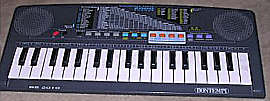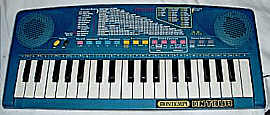
(picture taken from eBay)
|

(picture taken from eBay)
|
This 2 note polyphonic Bontempi tablehooter was apparently one of the successors of the Bontempi B50. The sound of the internal speakers is quite tinny and sounds like coarse 8 bit waveform resolution, but fortunately at least the cruel beeping continuous tone of the B50 is gone. All non- percussion sounds are made from combinations of 2 static waveform samples with volume and pitch envelopes. Interesting is that the thing has a so-called synthesizer, which in fact only replaces the pitch envelope and/ or volume envelope of a sound with 1 of 5 different preset ones. Also certain combinations of 2 preset sounds can be layered in a way that all together 2000 sounds can be generated. Although these are simple combinations of presets those rarely deserve the term "synthesizer", the instrument can make some funny, howling sounds and strange stereo crossfade and panning effects those are quite unusual and not often heard. Fans of Rob Hubbard's C64 SID compositions may easily fall in love with it.
Unfortunately a keyboard flaw often makes the 2 polyphony voices cancel out each other during fast play, and also some synthesizer settings or the use of rhythm forces monophonic play, which limits the usability. But for lead synth voices or pads it is otherwise nice because it has certain unusual grainy special sounds those don't exist on average modern standard instruments.
All preset sounds, rhythms and demos are selected by a 4 digit number entered with the buttons {"1", "2" ,"3", "4"}. Despite there are 56 empty fields in the "sounds bank" matrix table, entering any other sound numbers than the official ones only select given preset sounds or do nothing; I found no hidden easteregg numbers there.
The preset sounds partly include envelopes those are not selectable
by the envelope select buttons. E.g. the "telephone" sound uses a fast
pitch switching envelope (squarewave vibrato) which can be replaced by
pressing the "frequency" buttons (i.e. the digital phone ring sound character
disappears), but it can not be switched back to the original envelope with
these buttons, because that envelope is special and not available by these
buttons. (Re- selecting the "telephone" sound always gets back its default
envelope.) The behaviour of the synthesizer buttons is thus sometimes a
bit confusing, particularly because after 6 presses they cycle back to
the 1st setting, which is not necessarily the default for a sound, and
there is no display to see which setting is currently selected (but selecting
a new sound always switches back to the corresponding default envelopes).
circuit bending detailsalternate button functionsThe CPU keyboard matrix inputs are pin 34 to 41. The outputs for keys are pin 12, 20, 22, 23, 24. (Pin 12 supports 3 additional higher note keys.) The control panel button outputs are pin 9 and 16. At the unused pin 18 a set of 8 additional buttons can be added, those do strange sound changes. I instead added a switch that switches the line to the control panel from pin 9 to pin 18. This changes the function of 8 buttons in the following way:
The "accomp. ring" button exchanges the bass of the accompaniment with a bell (carillon?), which sounds particularly nice with the "Jingle Bells" demo tune. The "stop" buttons stop and reset the accompaniment. The "?" buttons make a click noise. When these buttons are pressed together with keys, various strange sound changes appear. I don't know what this stuff shall be - it was likely a test feature. distortionThe stereo amplifier consists od 2 identical channels which each 3 transistors. To add distortion, solder a diode from the base of transistor Q10 to the wiper of a 50 kOhm pot, and the left end of the pot to GND; do the same with the other channel.volume controlFor real volume control, cut the trace between C14 (100 nF) and the 1µF electrolytic cap. Connect the wiper of a logarithmic 100 kOhm stereo potentiometer with the now open end of C14, and the right end of the pot with the open end of the 1µF cap; connect the left pot end with GND. Connect the same way the 2nd amplifier channel with the 2nd channel of the stereo pot. |

(picture taken from eBay)
|
This instrument of the "Bontempi On Tour" series was the direct technical successor of the Bontempi BS 2010. It is almost completely identical with the latter (including the annoying polyphony flaw and beeping demultiplexer noise); the only difference is that it has a blue case, a 9V DC mains adapter jack and instead of 64 it features now 105 layered preset sound combinations and thus provides 3000 sounds in total (although the label "electronic synth" is gone), because its "sounds bank" matrix table contains far less empty entries (the ones identical with the BS 2010 have even the same numbers). Strange is that in spite of this small internal software update has made most of the combinations selectable, there are still 15 empty fields (2 diagonal rows) in the matrix; I am not sure if this was a technical limitation or why Bontempi didn't make all 120 combinations available (by marketing reasons because it wouldn't have resulted in a round thousands number of sounds???).
I haven't examined the hardware closer yet, but the sound and behaviour
of this instrument (including rhythms and demos) seems to be fully identical
with my BS 2010.
I own no original manuals for these instruments, thus there might be still features I don't know yet (although by the simplicity of the instruments I don't assume this). If you like the sound style of these instruments, also watch out for Bontempi ET 202. (It has no synth, but 4 note polyphony and nice, arpeggio- like accompaniment.) Another great digital lo-fi synth with strange howling sounds is the Casio SA-35. Other keyboards with the same case style like the KE 3860 (but B40 hardware inside) were released in blue as Bontempi On Tour KE 3760 and in orange (with different demo) as Bontempi - Confetti Kla4. Another Bontempi Keyboard with nice howling synth sounds is the Bontempi GT 770.
Wanted:
I am still looking for the mysterious
Bontempi BS 3000 synthesizer
keyboard. It had a similar case like my B50,
but was claimed to have 3000 sound combinations, 120 individual sounds,
24 rhythms, 12 demos and up to 6 note polyphony - apparently it was the
top of the line model of Bontempi's pre "System 5" mini keyboards. Unfortunately
it seems to be terribly rare - it appeared yet not a single time on eBay,
thus I am not sure if it was released at all, or if it became vapourware
of that only some prototypes were made (like with the Commodore C65
computer). The only hint to its existence was this advertisement on the
Bontempi
homepage of the year 2000.
| removal of these screws voids warranty... | ||
 |
||
|
|